Maysara
by
Terry Sullivan
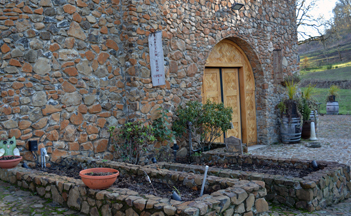 Summary: Moe and Flora Momtazi escaped from Iran in the 1982. They eventually bought property in the Willamette Valley where they planted vineyards on gently sloping hills and built a winery and tasting room that will impress. Wine enthusiasts will learn about the ancient Persian Empire and the influence on wine.
Summary: Moe and Flora Momtazi escaped from Iran in the 1982. They eventually bought property in the Willamette Valley where they planted vineyards on gently sloping hills and built a winery and tasting room that will impress. Wine enthusiasts will learn about the ancient Persian Empire and the influence on wine.
Today, wine in Iran is not accepted. Why then would a couple born and raised in Iran plant vineyards and craft wines? The land encompassing what is now Iran was not always hostile to alcohol. During the ancient Persian Empire, wine grapes were grown on this land and wines were made. What is now Iran and the surrounding countries are at the center of the ancient wine world. The earliest wines were made South of the Greater Caucasus Mountains 8,000 years ago. People made wines for thousands of years prior to Western Europe’s first plantings of grapevines.
This winemaking history and culture is what Moe, Flora and the Momtazi family want to educate wine enthusiasts. Visitors will notice the names of wines are in Persian. The winery name “Maysara” means “house of wine.”
Wine Journey
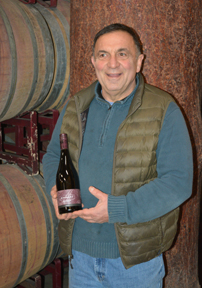 Moe (pictured left) is a civil engineer. As his career progressed, Moe and Flora began to think about what they could become involved with that the whole family could participate. The strong family connection and desire to educate about the Persian and Iranian culture led to the idea of purchasing land, planting vineyards and crafting wine. Naseem Momtazi, noted that her, “parents also like wine.”
Moe (pictured left) is a civil engineer. As his career progressed, Moe and Flora began to think about what they could become involved with that the whole family could participate. The strong family connection and desire to educate about the Persian and Iranian culture led to the idea of purchasing land, planting vineyards and crafting wine. Naseem Momtazi, noted that her, “parents also like wine.”
Maysara is a family business in the truest sense. Moe and Flora participate in all aspects of the winemaking process from the planting of the vines to bottling the wine. Flora also does the accounting for the winery. All three daughters are involved in the business. Eldest daughter, Tahmiene is the winemaker. Naseem heads the sales and marketing for the wine and Hanna is the events manager and in charge of hospitality for the winery.
Maysara Winery was founded in 2001. The family not only have a passion for wine, they are also passionate about farming and have bridged the gap from ancient farming to modern day methods.
Vineyards
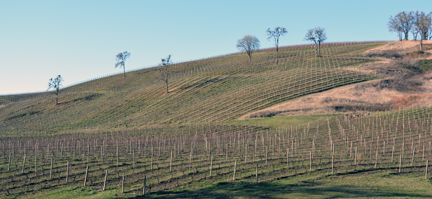 The planting of the vineyards was a massive project. While clearing the land, trees were removed as well as stones. These were later used to construct the winery. The vineyards are biodynamically farmed. In a very simplistic view, biodynamic farming is closer to the way farming use to be done prior to the formation of the petrochemical industry. Maysara’s use of biodynamic farming links back to some ancient farming practices that were used in ancient Persia. Many of the plants used to make the teas that are sprayed on the vineyard are grown on the estate. A few of the items need to make teas are purchased.
The planting of the vineyards was a massive project. While clearing the land, trees were removed as well as stones. These were later used to construct the winery. The vineyards are biodynamically farmed. In a very simplistic view, biodynamic farming is closer to the way farming use to be done prior to the formation of the petrochemical industry. Maysara’s use of biodynamic farming links back to some ancient farming practices that were used in ancient Persia. Many of the plants used to make the teas that are sprayed on the vineyard are grown on the estate. A few of the items need to make teas are purchased.
There are 250 acres under vine on a property that consists of 535 to 560 acres. Naseem explained that the property consists of 535 acres if using a bird’s eye grid. However much of the property is hilly and the elevation of the hills adds additional average to the property. Varietal grapes planted include Pinot Gris, Pinot Blanc, Riesling, Muscat and Pinot Noir. There are several clones of Pinot Noir in the vineyards.
A portion of the harvest is sold to other wineries. A greenhouse on the property has grafted plants on different rootstocks available for planting.
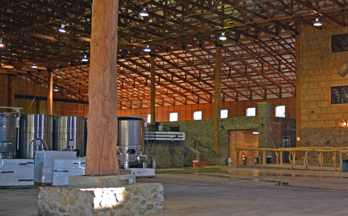 Winery
Winery
The winery is as much a work of art as it is a production facility. The large warehouse area does not resemble a warehouse. Moe said, “ About 95% of the building was made with items from the property.” All of the stones used for the stone work were gathered from the property. Hugh Douglas fir trees provide the columns throughout the winery spaces. The wood from 1,100 wine barrels were used on the interior walls above the stonework. Barrel heads were used to make the wood flooring in one area that is utilized for events. The property has three mills used to create the wood used in the winery construction.
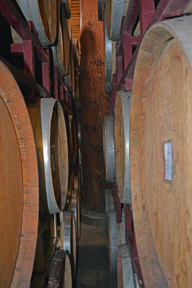 The winery is on two levels to take advantage of gravity flow. Stainless steel tanks and barrels are dwarfed by the enormity of the building. The majority of barrels are on a lower level that helps maintain constant temperatures. In the barrel room, you can view the enormous Douglas fir pillars. There is certainly room for growth in the winery. Current production is between 2,600 and 3,200 cases. All wines are fermented using natural yeasts, another practice that has ancient winemaking roots.
The winery is on two levels to take advantage of gravity flow. Stainless steel tanks and barrels are dwarfed by the enormity of the building. The majority of barrels are on a lower level that helps maintain constant temperatures. In the barrel room, you can view the enormous Douglas fir pillars. There is certainly room for growth in the winery. Current production is between 2,600 and 3,200 cases. All wines are fermented using natural yeasts, another practice that has ancient winemaking roots.
Wines
As we tasted wines in the tasting room while Naseem explained the connection between the wine’s name and Persia. The tasting room has an exotic feel with the stones and wood obtained from the property. Persian rugs and a tapestry set an ancient world theme in this striking setting.
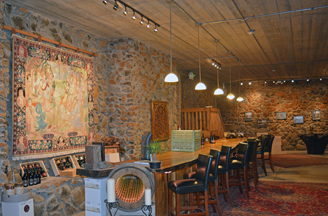 The 2014 Arsheen Pinot Gris was named after the princess Arsheen from 500 BC. The light yellow colored wine with 12.5% alcohol offered citrus, notably grapefruit with some notes of tropical fruits. The finish was crisp and fruity. The 2014 Autees Pinot Blanc was named for the Persian goddess that protects plants, trees and the earth. The light yellow colored wine, with 12.5% alcohol offered floral and fruit notes. The finish was crisp ad citrusy with a trace of tropical fruits.
The 2014 Arsheen Pinot Gris was named after the princess Arsheen from 500 BC. The light yellow colored wine with 12.5% alcohol offered citrus, notably grapefruit with some notes of tropical fruits. The finish was crisp and fruity. The 2014 Autees Pinot Blanc was named for the Persian goddess that protects plants, trees and the earth. The light yellow colored wine, with 12.5% alcohol offered floral and fruit notes. The finish was crisp ad citrusy with a trace of tropical fruits.
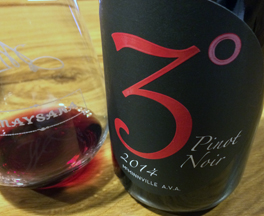 The 2014 3º was a Pinot Noir crafted by the three sisters Tahmiene, Naseem and Hanna. Their goal was to create an affordable Pinot Noir made from quality grapes. The wine was a transparent ruby with pink hue color and had 13.5% alcohol. The aroma and taste reminded me of red and black berry fruit and spices. The wine had a medium-body and mild tannins. The finish was fruity with a touch of pepper.
The 2014 3º was a Pinot Noir crafted by the three sisters Tahmiene, Naseem and Hanna. Their goal was to create an affordable Pinot Noir made from quality grapes. The wine was a transparent ruby with pink hue color and had 13.5% alcohol. The aroma and taste reminded me of red and black berry fruit and spices. The wine had a medium-body and mild tannins. The finish was fruity with a touch of pepper.
The 2009 Jamsheed Pinot Noir was named after Persian king. The transparent ruby colored wine with 13.7% alcohol offered black fruits and spices. The wine had a medium to full body and medium to bold tannins. The crisp finish had fruit yielding to spices. The 2011 Cyrus Pinot Noir was named after a Persian king. The 12.5% alcohol wine had a transparent ruby color. It put forth black fruits and spices. The wine had a medium to full body and medium tannins. The finish was crisp with and integration of fruit and spices. The 2010 Asha Pinot Noir was named after a Persian word referring to someone with a clean conscience. The transparent ruby colored wine with 13.5% alcohol had raspberries and cherries on the aroma and taste. The had a medium to full body and medium to bold tannins. The spicy finish had traces of fruit.
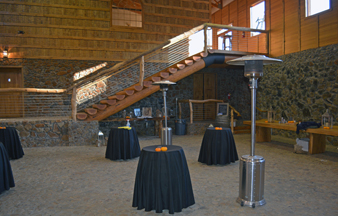 Events
Events
There are several areas throughout the winery that are utilized for events. A number of events are held at the winery including corporate, baby showers, weddings and parties. One event area is formal. The beautiful wood floor can serve as a ballroom.
Wine enthusiasts can visit a unique winery that utilized the property to build it. The architecture is photogenic and the biodynamic wines are thought provoking.
Maysara Winery
15765 Southwest Muddy Valley Road
McMinnville, Oregon 97128
GPS: N 45º 08.909’ W 123º 18.477’
Article written December 2015
Support the following Oregon Wineries.
 |
 |
 |
|
| Civic Winery | King Estate | Sweet Cheeks Winery & Vineyard | |
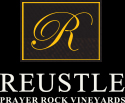 |
|||
| Reustle Prayer Rock Vineyard | Youngberg Hill |
